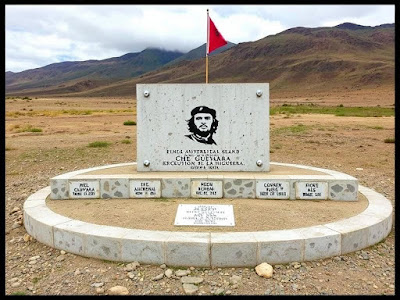Che Guevara: A Revolutionary Icon with an Everlasting Legacy
Che Guevara, a name synonymous with revolution and resistance, continues to capture imaginations worldwide, decades after his death. Born Ernesto Guevara de la Serna on June 14, 1928, in Rosario, Argentina, his life journey from medical student to iconic revolutionary leader is a compelling narrative of idealism, struggle, and sacrifice.
Early
Life and Political Awakening
Che Guevara grew up in a well-to-do,
left-leaning family. Despite battling asthma throughout his life, he was a
voracious reader and an exceptional student. His early exposure to works by Karl
Marx, Friedrich Engels, and Sigmund Freud ignited his
interest in socialism and the plight of the poor and oppressed.
The
Impact of "The Motorcycle Diaries"
During his youth, Che embarked on a
transformative journey across Latin America as a medical student. This
adventure, immortalized in his memoir The Motorcycle Diaries, revealed
the pervasive poverty, inequality, and social injustices of the continent.
Witnessing these realities solidified his commitment to radical change and
reshaped his worldview.
The
Cuban Revolution: Che’s Rise to Prominence
The
revolutionary path of Che Guevara took a decisive turn in 1955 when he
encountered Fidel Castro in Mexico. Castro
was planning an armed insurrection against Fulgencio Batista's
dictatorial regime in Cuba. Che joined Castro’s 26th of July Movement,
eventually becoming a pivotal figure in the Cuban Revolution.
Guerrilla
Warfare in Sierra Maestra
Che’s time in the Sierra Maestra
mountains was marked by strategic brilliance and unyielding dedication.
Initially joining as a medical officer, he quickly demonstrated extraordinary leadership
and combat skills. These qualities earned him the rank of comandante, a
key leadership role in the revolution’s success.
In 1959, the movement succeeded in
overthrowing Batista, marking the beginning of Che’s influence in
post-revolutionary Cuba.
Post-Revolutionary
Role: Building Socialist Cuba
Following the revolution, Che played a significant role in shaping Cuba’s socialist state. His contributions
included:
- Economic Leadership:
As Minister of Industries, he spearheaded initiatives to diversify Cuba’s
economy.
- Diplomatic Advocacy:
Representing Cuba internationally, Che promoted socialist solidarity and
opposed imperialism.
- Socialist Philosophy:
In his essay, Man and Socialism in Cuba, Che emphasized the
importance of moral incentives and selflessness in building a
revolutionary society.
Beyond
Cuba: Global Revolutionary Efforts
Che’s revolutionary vision extended
beyond Cuba. In 1965, he left Cuba to support guerrilla movements worldwide.
The
Congo Mission
Che traveled to the Congo to
assist anti-colonial forces fighting pro-Western regimes. However, the mission
faced insurmountable challenges, including poor coordination and lack of local support,
leading to its eventual failure.
The
Bolivia Campaign
Determined to ignite a Latin
American revolution, Che entered Bolivia in 1966. Despite his efforts, the
campaign struggled with limited local support, difficult terrain, and intense
military opposition, culminating in his capture by the Bolivian army on
October 8, 1967. He was executed the following day, cementing his legacy as a
revolutionary martyr.
Iconography
and Controversy
Che Guevara’s
likeness has evolved into a lasting emblem of defiance and revolution. Alberto Korda's iconic photograph Guerrillero Heroico epitomizes resistance and idealism. This image has been reproduced
globally on posters, murals, and merchandise, symbolizing defiance and
revolutionary spirit.
However, his legacy is polarizing.
Critics highlight his role in executions and his advocacy for armed struggle,
while supporters revere him as a champion of the oppressed.
The
Legacy of Che Guevara
Che’s life and ideals continue to
inspire activists worldwide. He remains a revered figure in Latin America,
symbolizing the fight against inequality and imperialism. His writings,
speeches, and revolutionary actions offer profound critiques of capitalist
exploitation and a vision of a just society.
Enduring
Influence
Despite controversies, Che Guevara’s
philosophy and legacy persist in political discourse and popular culture. His
call to action, “Let the world change you, and you can change the world,”
resonates deeply, reminding us of the ongoing struggle for justice and
equality.
Conclusion
Che Guevara’s transformative journey
from a medical student to a revolutionary icon exemplifies his unwavering
commitment to justice and social change. While his methods and legacy remain
debatable, his influence on global revolutionary movements is
undeniable. Che’s enduring image and ideals inspire generations to challenge
oppression and strive for a better world.
Che’s
famously said “ The revolution isn't an apple that falls when it's ripe. You have to make
it fall. ”
Find out my favorite Health and Fitness products here: https://linktr.ee/iamatiiq




.jpg)

.jpg)
Comments
Post a Comment